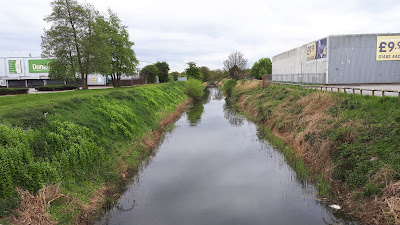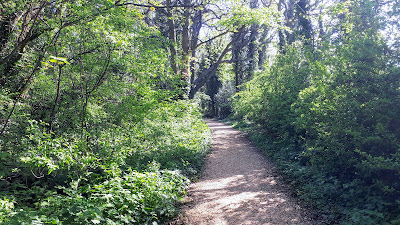Since the lockdown started, I've been birding as part of my daily exercise walk. The local cemetery, which I have covered before in this blog, is a ten minute walk away and sometimes I don't come across anybody in my walk, ideal for social distancing. In the spring, the cemetery is full of song, Chiffchaffs and Blackcaps have several territories. The lush undergrowth supports plenty of Wrens, Robins and Dunnocks. The other day I witnessed a food pass between a pair of Sparrowhawks.
This cemetery is actually two, on the eastern side is the General Cemetery, now not an active burial ground. It was acquired by Hull City Council in 1974. The lack of maintenance resulted in the emergence of dense woodland with understory of ivy, brambles and some garden plants like cherry laurel. There are large ashes, some oaks, beech and sycamore, some engulfing the old headstones. The base of lime trees is thick with epicormic growth, which provides additional shelter.
Western cemetery
The Western cemetery, which is split by Chanterlands Avenue, is open parkland, also with some mature trees. In both there are plenty of Yew.
Both cemeteries include a diversity of mature trees, and some fallen and standing wood. Given the lack of woodland in the local area, the cemeteries, particularly the General Cemetery, provide a haven for woodland birds like Song thrushes, Treecreepers, Stock Doves and Great Spotted Woodpeckers.
I went for my daily walk to the cemetery this morning. I'm not taking as many photos as normal, but I took some with my phone and I had to take my camera out of my bag to photograph the blackcap that sung in the flowering maple (top shot). It was a fine sunny morning and a Treecreeper, Goldcrest, Chiffchaff were also singing.
A path in the General cemetery.
Ivy-clad trees in the General Cemetery.
A large Ash in the Western Cemetery.
The mowing misses some weeds on the edges of the old fallen headstones.
An exposed root plate and dead wood.
Flowering cherry.
A large copper beech had fallen overnight the other day.
Flowering maple.
A Mistletoe in a tree stump.
Some mature pine trees.
Today's Bird list
- Blackbird
- Blackcap
- Blue Tit
- Bullfinch
- Carrion Crow
- Chaffinch
- Chiffchaff
- Collared Dove
- Dunnock
- Feral Pigeon
- Goldcrest
- Goldfinch
- Great Tit
- Greenfinch
- Herring Gull
- House Sparrow
- Lesser Black-backed Gull
- Magpie
- Mistle Thrush
- Robin
- Song Thrush
- Stock Dove
- Treecreeper
- Woodpigeon
- Wren











 In today's lockdown morning walk, I ventured to Oak Road lake via Pearson Park, Beverley Road and Clough Road. In ended up not spending much time at the lake proper, as I was distracted by plenty of birds along the way. I found a walkable stretch of the Beverley and Barmston drain by Clough Rd.
In today's lockdown morning walk, I ventured to Oak Road lake via Pearson Park, Beverley Road and Clough Road. In ended up not spending much time at the lake proper, as I was distracted by plenty of birds along the way. I found a walkable stretch of the Beverley and Barmston drain by Clough Rd.













































